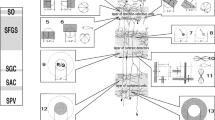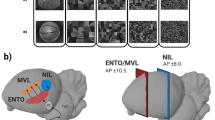Summary
In the grass frogRana temporaria, various classes of tectal neurons were identified by means of intracellular recording and iontophoretic staining using potassium-citrate/Co3+-lysine-filled micropipettes, which have been defined previously by extracellular recording methods.
Class T5(1) neurons had receptive fields (RF) of 33°±5° diameter. In response to a moving 8°×8° square (S), a 2°×16° worm-like (W), or a 16°×2° antiworm-like (A) moving stripe, these cells showed excitatory postsynaptic potentials (EPSPs) and spikes which were interrupted occasionally by small inhibitory postsynaptic potentials (IPSPs). The excitatory responses (R) were strongest towards the square (RS) and less to the worm (RW). For the antiworm (RA) the responses were smallest or equal to the worm stimulus yielding the relationship RS>RW≧RA. Some of these cells were identified as pear-shaped or large ganglionic neurons, whose somata were located in the tectal cell layer 8. The somata of other large ganglionic neurons were found in layer 7 and the somata of other pear-shaped neurons at the top of layer 6, both displaying T5(1) properties.
Class T5(2) neurons (RF=34°±3°) responded with large EPSPs and spikes, often interrupted by small IPSPs, when their RF was traversed by the square stimulus. The excitatory activity was somewhat less to the worm stimulus, whereas no activity at all, or only IPSPs, were recorded in response to the antiworm-stimulus; thus yielding the relationship for the excitatory activity RS>RW>RA≈ 0. Such a cell was identified as pyramidal neuron; the soma was located at the top of layer 6, with the long axon travelling into layer 7 to the medulla oblongata.
Class T5(3) neurons (RF=29°±6°) showing EPSPs and spikes according to the relationship RS>RA>RW have been identified as large ganglionic neurons. Their somata were located in layer 8.
Class T5(4) neurons (RF=24±7°) responded only to the square stimulus with EPSPs and spikes, sometimes interrupted by IPSPs and yielding the relationship RS>RA≈RW≈0. The somata of these large ganglionic or pear-shaped neurons were located in layer 8.
Class T1(1) neurons (RF=30°–40°) were most responsive to stimuli moving at a relatively long distance in the binocular visual field, and have been identified as pear-shaped neurons. Their somata were located in layer 6.
Further neurons are described and morphologically identified which have not yet been classified by extracellular recording methods. For example,IPSP neurons (RF=20°–30°) responded (R′) with IPSPs only according to the relationship R′S>R′A≈ R′W. The somata of these pear-shaped neurons were located in layer 6.
The properties of tectal cells in response to electrical stimulation of the optic tract and to brisk changes of diffuse illumination suggest certain neuronal connectivity patterns. The results support the idea ofintegrative functional units (assemblies) of connected cells which are involved in various perceptual processes, such as configurational prey selection expressed by T5(2) prey-selective neurons.
Similar content being viewed by others
Abbreviations
- A :
-
antiworm-like 16°×2° stripe stimulus with long axis perpendicular to the direction of movement
- W :
-
wormlike 2°×16° stripe stimulus with long axis oriented parallel to the direction of movement
- S :
-
square 8°×8° moving stimulus
- ERF :
-
excitatory receptive field
- IRF :
-
inhibitory receptive field
- RF :
-
receptive field
- EPSP :
-
excitatory postsynaptic potential
- IPSP :
-
inhibitory postsynaptic potential
References
Antal M, Matsumoto N, Székely G (1986) Tectal neurons of the frog: Intracellular recording and labeling with cobalt electrodes. J Comp Neurol 246:238–253
Arbib MA (1982) Modelling neuronal mechanisms of visuomotor coordination in frog and toad. In: Amari S, Arbib MA (eds) Competition and cooperation in neural nets. Springer, Berlin Heidelberg New York, pp 342–370
Ewert J-P (1971) Single unit response of the toad (Bufo americanus) caudal thalamus to visual objects.Z Vergl Physiol 74:81–102
Ewert J-P (1974) The neural basis of visually guided behavior. Sci Am 230:34–42
Ewert J-P (1984) Tectal mechanisms that underlie prey-catching and avoidance behaviors in toads. In: Vanegas H (ed) Comparative neurology of the optic tectum. Plenum Press, New York London, pp 247–416
Ewert J-P (1985) The Niko Tinbergen Lecture 1983: Concepts in vertebrate neuroethology. Anim Behav 33:1–30
Ewert J-P (1986) Neuroethology: Toward a functional analysis of stimulus-response mediating and modulating neural circuitries. In: Ellen P, Thinus-Blanc C (eds) Cognitive processes and spatial orientation in animal and man. Martinus Nijhoff, Dordrecht (in press)
Ewert J-P (1987) Measuring visual discrimination: Principles in configurational perception. In: Guthrie DM (ed) Methods and aims in neuroethology. Univ Manchester Press, Manchester U.K. (in press)
Ewert J-P, Seelen W von (1974) Neurobiologie und System-Theorie eines visuellen Muster-Erkennungsmechanismus bei Kröten. Kybernetik 14:167–183
Ewert J-P, Wietersheim A von (1974) Musterauswertung durch tectale und thalamus/praetectale Nervennetze im visuellen System der Erdkröte (Bufo bufo L.). J Comp Physiol 92:131–148
Ewert J-P, Speckhardt I, Amelang W (1970) Visuelle Inhibition und Exzitation im Beutefangverhalten der Erdkröte (Bufo bufo L.) Z Vergl Physiol 68:84–110
Ewert J-P, Borchers H-W, Wietersheim A von (1978) Question of prey feature detectors in the toad'sBufo bufo (L.) visual system: A correlation analysis. J Comp Physiol 126:43–47
Ewert J-P, Borchers H-W, Wietersheim A von (1979) Directional sensitivity, invariance, and variability of tectal T5 neurons in response to moving configurational stimuli in the toadBufo bufo (L.). J Comp Physiol 132:191–201
Ewert J-P, Burghagen H, Schürg-Pfeiffer E (1983) Neuroethological analysis of the releasing mechanism of prey-catching behavior in toads. In: Ewert J-P, Capranica RR, Ingle DJ (eds) Advances in vertebrate neuroethology. Plenum Press, New York, pp 413–475
Fite KV (ed) (1976) The amphibian visual system: A multidisciplinary approach. Academic Press, New York London
Freeman JA, Norden JJ (1984) Neurotransmitters in the optic tectum of nonmammalians. In: Vanegas H (ed) Comparative neurology of the optic tectum. Plenum Press, New York London, pp 469–546
Görcs T, Antal M, Olah E, Székely G (1979) An improved cobalt labeling technique with complex components. Acta Biol Acad Sci Hung 30 (1–2): 79–86
Grüsser O-J, Grüsser-Cornehls U (1970) Die Neurophysiologie visuell gesteuerter Verhaltensweisen bei Anuren. Verh Dtsch Zool Ges 64:201–218
Grüsser O-J, Grüsser-Cornehls U (1976) Neurophysiology of the anuran visual system. In: Llinás R, Precht W (eds) Frog neurobiology. Springer, Berlin Heidelberg New York, pp 298–385
Grüsser-Cornehls U (1984) The neurophysiology of the amphibian optic tectum. In: Vanegas H (ed) Comparative neurology of the optic tectum. Plenum Press, New York London, pp 211–245
Himstedt W (1982) Prey selection in salamanders. In: Ingle DJ, Goodale MA, Mansfield RJW (eds) Analysis of visual behavior. MIT Press, Cambridge Mass, pp 47–66
Hongo T, Kudo N, Yamashita M, Ishizuka N, Mannen H (1981) Transneuronal passage of intraaxonally injected horseradish peroxidase (HRP) from group Ib and II fibres into the secondary neurons in the dorsal horn of the cat spinal cord. Biomed Res 2:722–727
Hubel DH, Wiesel TN (1962) Receptive fields, binocular interaction and functional architecture in the cat's visual cortex. J Physiol (Lond) 160:106–154
Hubel DH, Wiesel TN (1977) Ferrier Lecture: Functional architecture of macaque monkey visual cortex. Proc R Soc Lond B 198:1–59
Hughes TE, Hall WC (1985) The transneuronal transport of horseradish peroxidase in the visual system of the frog,Rana pipiens. Soc Neurosci Abstr 11:1008
Ingle D (1975) Selective visual attention in frogs. Science 188:1033
Ingle D (1983) Brain mechanisms of visual localization by frogs and toads. In: Ewert J-P, Capranica RR, Ingle DJ (eds) Advances in vertebrate neuroethology. Plenum Press, New York London, pp 177–226
Kuljis RO, Karten HJ (1982) Laminar organization of peptide-like immunoreactivity in the anuran optic tectum. J Comp Neurol 212:188–201
Kuljis RO, Karten HJ (1983) Modifications in the laminar organization of peptide-like immunoreactivity in the anuran optic tectum following retinal deafferentiation. J Comp Neurol 217:239–251
Lara R, Cervantes F, Arbib MA (1982) Two-dimensional model of retinal-tectal-pretectal interactions for the control of prey-predator recognition and size preference in amphibia. In: Amari S, Arbib MA (eds) Competition and cooperation in neural nets. Springer, Berlin Heidelberg New York, pp 371–393
Lázár G (1984) Structure and connections of the frog optic tectum. In: Vanegas H(ed) Comparative neurology of the optic tectum. Plenum Press, New York London, pp 185–210
Lázár G, Tóth P, Csank G, Kicliter E (1983) Morphology and location of the tectal projection neurons in frogs: A study with HRP and cobalt-filling. J Comp Neurol 215:108–120
Llinás R, Precht W (eds) (1976) Frog neurobiology. Springer, Berlin Heidelberg New York
Matsumoto N, Antal M (1984) Physiological and morphological study of prey and predator detecting neurons in the frog tectum. Proc 6th Annu Meet Jpn Soc Gen Comp Physiol Abstr, p 169
Matsumoto N, Bando T (1980) Excitatory synaptic potentials and morphological classification of tectal neurons of the frog. Brain Res 192:39–48
Megela AL, Borchers H-W, Ewert J-P (1983) Relation between activity of tectal neurons and prey-catching behavior in toadsBufo bufo. Naturwissenschaften 70:100–101
Milson JA, Mitchell JF (1977) The action of amino acids on evoked responses in the frog optic tectum. Br J Pharmacol 59:484
Mountcastle VB (1957) Modality and topographic properties of single neurons of cat's somatotopic sensory cortex. J Neurophysiol 20:308–434
Reiner A, Karten HJ, Brecha NC (1982) Enkephalin-mediated basal ganglia influences over the optic tectum: Immun-histochemistry of the tectum and the lateral spiriform nucleus in pigeon. J Comp Neurol 208:37–53
Roth G, Jordan M (1982) Response characteristics and stratification of tectal neurons in the toadBufo bufo (L.). Exp Brain Res 45:393–398
Satou M, Ewert J-P (1985) The antidromic activation of tectal neurons by electrical stimuli applied to the caudal medulla oblongata in the toadBufo bufo L. J Comp Physiol A 157:739–748
Schürg-Pfeiffer E, Ewert J-P (1981) Investigation of neurons involved in the analysis of Gestalt prey features in the frogRana temporaria. J Comp Physiol 141:139–152
Székely G (1973) Anatomy and synaptology of the optic tectum. In: Jung R (ed) Handbook of sensory physiology, vol 7. Springer, Berlin Heidelberg New York
Székely G, Lázár G (1976) Cellular and synaptic architecture of the optic tectum. In: Llinás R, Precht W (eds) Frog neurobiology. Springer, Berlin Heidelberg New York, pp 407–437
Székely G, Setalo G, Lázár G (1973) Fine structure of the frog's optic tectum: Optic fibre termination layers. J Hirnforsch 14:189–225
Urban L, Székely G (1983) Intracellular staining of motoneurons with complex cobalt compounds in the frog. J Neurobiol 14:157–161
Vanegas H (ed) (1984) Comparative neurology of the optic tectum. Plenum Press, New York London
Wietersheim A von, Ewert J-P (1978) Neurons of the toad's (Bufo bufo L.) visual system sensitive to moving configurational stimuli: a statistical analysis. J Comp Physiol 126:35–42
Weerasuriya A, Ewert J-P (1981) Prey-selective neurons in the toad's optic tectum and sensori-motor interfacing: HRP studies and recording experiments. J Comp Physiol 144:429–434
Zieglgänsberger W, Reiter C (1974) Interneuronal movement of Procion Yellow in cat spinal neurons. Exp Brain Res 20:527–530
Author information
Authors and Affiliations
Rights and permissions
About this article
Cite this article
Matsumoto, N., Schwippert, W.W. & Ewert, J.P. Intracellular activity of morphologically identified neurons of the grass frog's optic tectum in response to moving configurational visual stimuli. J. Comp. Physiol. 159, 721–739 (1986). https://doi.org/10.1007/BF00603726
Accepted:
Issue Date:
DOI: https://doi.org/10.1007/BF00603726




